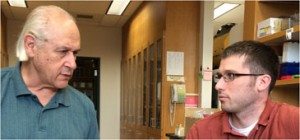Treating cancer in A-T without exacerbating central nervous damage
Research Project information
Principal researcher: Professor Mark Noble
Institute: University of Rochester, New York, USA
Grant award: $158,600
Project Completion Date: December 2016
Project Overview
Children with A-T have an increased incidence of developing cancers, primarily leukaemia and lymphoma. These children also bear the additional risk that the mutation causing A-T makes cells more susceptible to agents that cause DNA damage. These children are therefore at risk of developing secondary cancers as a result of their cancer treatment.
The goal of Professor Noble and his colleagues was to develop safer, but effective treatments for cancer in individuals with this condition.
How this project will help
It is hoped that finding more effective ways to target and treat cancers in A-T will minimise the exposure that affected children have to highly toxic cancer treatments. This would prevent further damage to the parts of their brains that are undergoing degeneration and reduce the chance that the cancer treatments will make them vulnerable to developing cancer again in the future.
Project Outcome
The funding provided by Action for A-T and Sparks enabled parallel funding from other sources and allowed Professor Noble and his team to make a number of important discoveries:
- Using research models, the team’s work highlighted a common weakness in several types of cancer cells that could be exploited as a therapeutic approach. This novel approach to cancer treatment may offer a greater margin of safety than current chemotherapeutic agents.
- They found drugs already in clinical use which can take advantage of this weakness in the cancer cells. As these approaches are based on discovering new properties of drugs already approved for other purposes, this would enable a quicker and less expensive transition to the clinic than for brand new drugs.
- A combination of drugs may make cancer cells in A-T more vulnerable to currently used treatments and thus would allow smaller and therefore less toxic doses to be used. This general treatment strategy also looks very promising for breast cancer, which occurs with increased frequency in individuals with A-T.
- The treatment strategy appears, in research models, to be remarkably safe for vulnerable cells of the brain, even in the models that lack functional ATM protein.
Publications
Campbell A, Krupp B, Bushman J, Noble M, Pröschel C, Mayer-Pröschel M. Hum Mol Genet. 2015 Nov 15;24(22):6331-49. Epub 2015 Aug 26 A novel mouse model for ataxia-telangiectasia with a N-terminal mutation displays a behavioural defect and a low incidence of lymphoma but no increased oxidative burden.
What Next?
The team made a surprising observation that the therapeutic approach considered most suitable for testing in human cells was effective in extending lifespan in female research models but not in male counterparts. This could be an important outcome, especially for breast cancer investigations. The team state that further studies are required to help understand these novel results.
Prof Noble also plans to investigate whether, now that they have identified novel cancer treatment approaches that are more sensitive, they can choose less toxic chemotherapy drugs to use along side them. This could mean replacing current chemotherapy drugs with those that appear to cause less damage to treated cells and also appear to be less neurotoxic than other anticancer agents they have examined.





